History Through Coins: The Era of Good Feelings
Posted on 8/11/2020
There are few periods in United States history that were largely free of political wrangling by parties, but the years roughly coinciding with the presidency of James Monroe (1817-25) have been labeled "The Era of Good Feelings" for their brief moment of near national harmony.
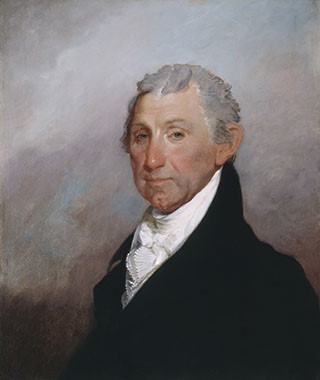 |
| President Monroe |
Americans had been deeply divided over the War of 1812, which pitted the United States against the British Empire over a variety of conflicts, most notably the seizure of American merchant ships and the impressment of their crews into the Royal Navy. These actions arose from Britain’s war against Emperor Napoleon of France, with both of these empires abusing neutral American shipping. When America finally won this conflict late in 1814, it helped to ease some of the internal tensions that had been simmering for years between the two dominant political parties. These were the Federalists, descendants of George Washington’s presidency who advocated a very strong central government, and the Democratic-Republicans, the party of Thomas Jefferson and his successors, which favored states' rights and a less-powerful federal government.
President James Madison (1809-17), himself a Democratic-Republican, had realized during the crisis of war that there were times when firm leadership from Washington, D.C., was necessary, and he sought to soften his party’s stance against it. At the same time, the Federalist Party was in disarray, having lost the White House in 1800 and suffering steady erosion since that time.
It was into this period of reconciliation that Madison’s fellow Virginian, James Monroe, was elected president in 1816. Though his Democratic-Republican Party prevailed, he sought to downplay politics and continue the transformation of the United States into a nation that respected all interests. This resulted in his running nearly unopposed for re-election in 1820, the first candidate since George Washington to enjoy such harmony among voters and, sadly, the last to know it, too.
In 1817, the US Mint resumed the coining of silver after a disastrous fire the year before that had precluded any silver or gold issues bearing that date. A half dollar die dated 1813 remained unused and was retrofitted with an overpunched numeral, creating one of the most obvious overdate varieties in United States coinage.
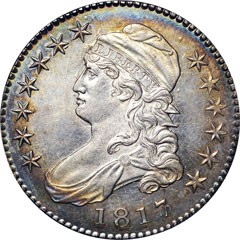 |
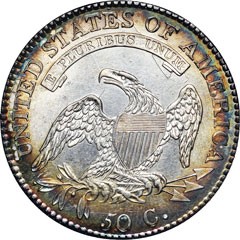 |
| 1817/3 Capped Bust Half Dollar, NGC MS 64Click images to enlarge. | |
The chaos of the Napoleonic Wars, during which America’s War of 1812 was a sideshow, upset international metal prices. This left United States gold coins worth more as bullion than their face value. Mintages of gold pieces plunged, and such coins often were exported to be melted and recoined into some other nation’s coinage. Few of the 1814-34 Half Eagles have survived, and it was not until August 1, 1834 that the weight of US gold coins was reduced, allowing the new issues to circulate freely once again.
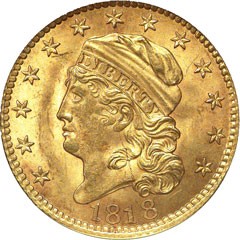 |
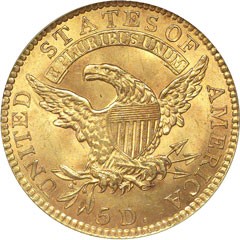 |
| 1818 Capped Head Half Eagle, NGC MS 64Click images to enlarge. | |
Over-speculation in the public lands being opened up to settlement, combined with largely unregulated issues of commercial banknotes, led to the first great financial panic in American history, rather unimaginatively titled the “Panic of 1819.” The Second Bank of the United States, established in 1816, sought to rein in some of this speculation by declining further loans at its western branches. Banks immediately suspended specie payments (gold and silver coin), leading to business failures and growing unemployment. This set the stage for Americans becoming resentful toward any sort of national bank, a movement carried through to its logical conclusion by President Andrew Jackson when the bank’s charter was up for renewal in 1836.
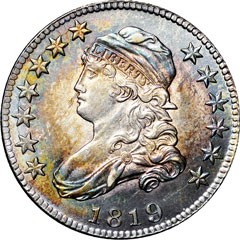 |
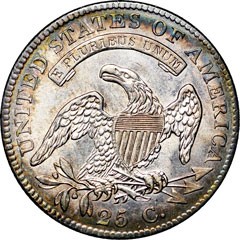 |
| 1819 Capped Bust Quarter Dollar, NGC MS 64Click images to enlarge. | |
The greatest issue left unresolved by America’s 1789 constitution was that of slavery. It was a sore that seemingly could only be bandaged but never healed. When Missouri, a territory where slavery was permitted, applied for statehood in 1820, this threatened the balance of congressional power between northern “free states” and southern “slave states.” Maine, hitherto a part of Massachusetts, also sought statehood, and it appeared that the solution was to admit both states in a single bill, since Maine did not permit slavery. The Missouri Compromise of 1820 passed, but it included a proviso that thereafter slavery was prohibited in the United States above 36⁰30′ northern latitude—with the glaring exception of Missouri. It was a fix that ultimately satisfied almost no one, and the same drama would play out again with each new state, until it finally led to the Civil War.
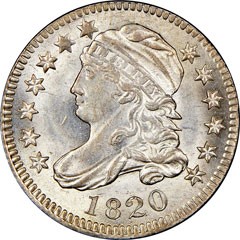 |
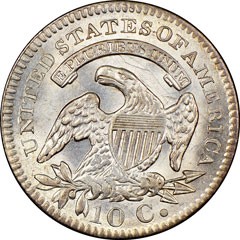 |
| 1820 Capped Bust Dime, NGC MS 65Click images to enlarge. | |
The Panic of 1819 still hung over the nation in 1821, making this portion of The Era of Good Feelings also one of economic misery. Despite this handicap, the Philadelphia Mint coined some 1,305,797 half dollars in 1821, that denomination being the silver piece most requested by banks and businesses. It’s likely that some of these coins actually bore earlier dates, as the Mint was thrifty and did not discard usable dies. A total of seven die marriages are known for 1821-dated halves, the coin illustrated being of the last one, Overton-107. It is pedigreed to the collections of “Colonel” E.H.R. Green and Eric P. Newman.
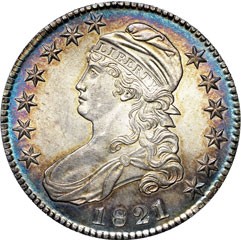 |
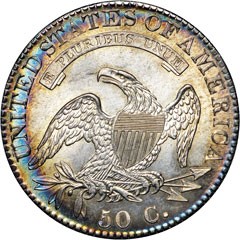 |
| 1821 Capped Bust Half Dollar, NGC MS 64★Click images to enlarge. | |
On April 25, 1822, the first installment of settlers arrived in what would become the new nation of Liberia 25 years later. A strip of coastline in West Africa had been purchased by the American Colonization Society as the projected new home for former slaves and free-born black people from America. The ACS had been founded in 1816 by Robert Finley. Though ostensibly established with the best of intentions, there were critics of this movement who claimed that some immigrants to Africa had been coerced into leaving the United States, which had been the only home they’d known. The ACS was ultimately accused of perpetuating slavery in America by removing many of the persons who were best suited to help in its abolition.
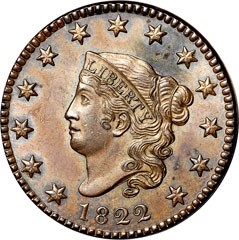 |
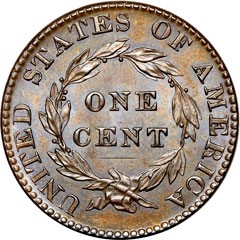 |
| 1822 Coronet Head Cent, NGC MS 64 BNClick images to enlarge. | |
On December 2, 1823, the United States issued a declaration that any European imposition on the newly independent nations of Central and South America would be interpreted as “the manifestation of an unfriendly disposition toward the United States.” In return for their acceptance of this declaration, the United States agreed to not interfere with the domestic affairs of European nations and to respect existing European colonies. Some years later, this declaration was branded “The Monroe Doctrine,” after President Monroe. A century later, his portrait appeared on a commemorative half dollar struck at the San Francisco Mint. Monroe shares its obverse with Secretary of State John Quincy Adams, who was the principal author of the doctrine’s text.
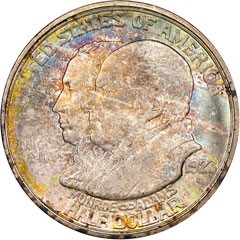 |
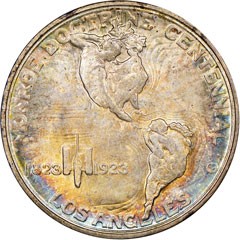 |
| 1823-1923-S Monroe Doctrine Half Dollar, NGC MS 67Click images to enlarge. | |
All good things must come to an end, and so it was with the relative political harmony of President Monroe’s two terms. Though the nation effectively had but one political party — the Democratic-Republicans (the current Republican Party dates only to 1856) — the election of 1824 witnessed four of its members going head-to-head for the top office. Secretary of State John Quincy Adams was opposed by Kentucky Senator Henry Clay, Tennessee Senator Andrew Jackson and Treasury Secretary William H. Crawford. None achieved sufficient electoral votes to win, and the US Constitution required that the matter be settled in the House of Representatives. Though Kentucky’s delegation was pledged to Jackson, Senator Clay persuaded it to vote for Adams, making similar arrangements with other state delegations. Adams was declared the winner, while Jackson cried foul and swore his vengeance. The Tennessean made good on this promise by defeating Adams’ bid for re-election four years later.
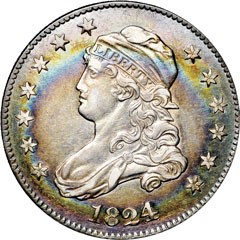 |
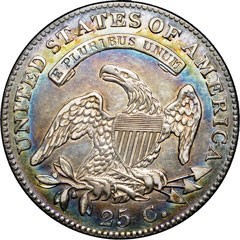 |
| 1824/2 Capped Bust Quarter Dollar, NGC AU 55Click images to enlarge. | |
Stay Informed
Want news like this delivered to your inbox once a month? Subscribe to the free NGC eNewsletter today!
